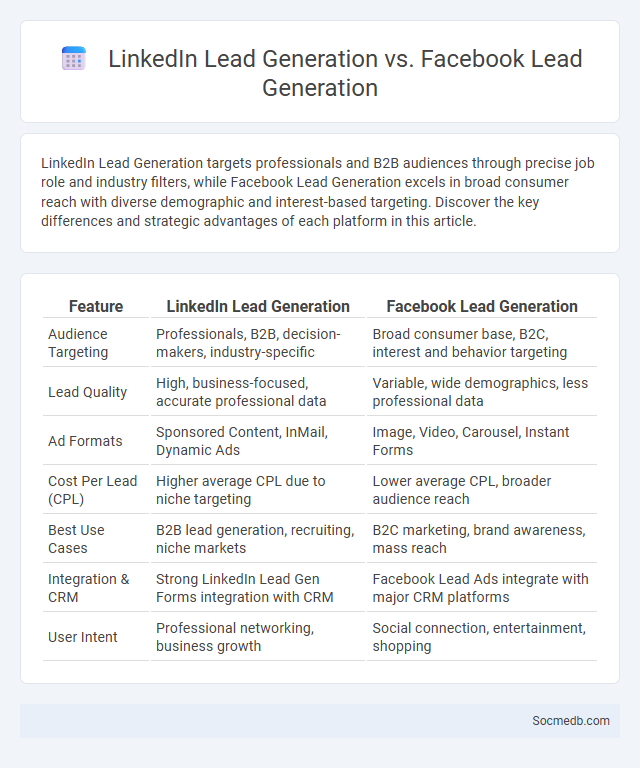
Photo illustration: LinkedIn Lead Generation vs Facebook Lead Generation
LinkedIn Lead Generation targets professionals and B2B audiences through precise job role and industry filters, while Facebook Lead Generation excels in broad consumer reach with diverse demographic and interest-based targeting. Discover the key differences and strategic advantages of each platform in this article.
Table of Comparison
| Feature | LinkedIn Lead Generation | Facebook Lead Generation |
|---|---|---|
| Audience Targeting | Professionals, B2B, decision-makers, industry-specific | Broad consumer base, B2C, interest and behavior targeting |
| Lead Quality | High, business-focused, accurate professional data | Variable, wide demographics, less professional data |
| Ad Formats | Sponsored Content, InMail, Dynamic Ads | Image, Video, Carousel, Instant Forms |
| Cost Per Lead (CPL) | Higher average CPL due to niche targeting | Lower average CPL, broader audience reach |
| Best Use Cases | B2B lead generation, recruiting, niche markets | B2C marketing, brand awareness, mass reach |
| Integration & CRM | Strong LinkedIn Lead Gen Forms integration with CRM | Facebook Lead Ads integrate with major CRM platforms |
| User Intent | Professional networking, business growth | Social connection, entertainment, shopping |
Introduction to Lead Generation
Social media platforms serve as powerful channels for lead generation by connecting businesses with targeted audiences actively seeking products or services. Utilizing precise content strategies and engaging visuals, you can attract, capture, and nurture potential customers through organic posts and paid advertisements. Leveraging tools such as LinkedIn Lead Gen Forms, Facebook Lead Ads, and Instagram Stories with call-to-actions enhances conversion rates and grows your sales pipeline effectively.
What is LinkedIn Lead Generation?
LinkedIn lead generation is the process of identifying and attracting potential clients or customers through LinkedIn's platform using targeted content, profile optimization, and advanced search filters. This method leverages LinkedIn's business-focused network to connect with decision-makers, generate quality leads, and build professional relationships. Effective LinkedIn lead generation enhances B2B marketing strategies by increasing conversion rates and expanding sales pipelines.
What is Facebook Lead Generation?
Facebook lead generation is a marketing strategy designed to capture potential customers' contact information directly through Facebook ads or forms without requiring users to leave the platform. This method leverages Facebook's targeting options to reach specific audiences, increasing the likelihood of generating high-quality leads. You can use these leads to build your email list, nurture prospects, and drive sales effectively.
Overview of General Lead Generation
Social media platforms like Facebook, LinkedIn, and Instagram serve as pivotal channels for lead generation by targeting specific demographics through tailored content and advertising. Utilizing advanced analytics and engagement metrics improves lead quality and conversion rates by identifying potential customers who exhibit buying intent. Integrating CRM tools with social media campaigns enhances lead management, tracking interaction history and optimizing follow-up strategies.
LinkedIn Lead Generation: Key Features and Benefits
LinkedIn lead generation offers powerful tools like advanced search filters, InMail messaging, and targeted sponsored content to connect with decision-makers in your industry. Your campaign benefits from detailed analytics and CRM integrations that streamline prospect tracking and relationship management. Maximize your outreach efficiency by leveraging LinkedIn's professional network to generate high-quality leads that align with your business objectives.
Facebook Lead Generation: Key Features and Benefits
Facebook Lead Generation offers advanced targeting options to help you reach specific audiences based on demographics, interests, and behaviors. Its seamless in-app lead forms simplify the data collection process, increasing conversion rates while reducing user friction. You benefit from real-time analytics and CRM integration, enabling efficient follow-up and improved campaign performance.
LinkedIn vs Facebook: Audience Targeting Capabilities
LinkedIn offers advanced audience targeting capabilities specifically tailored for professional demographics, allowing you to reach decision-makers, industry experts, and B2B clients with precision. Facebook excels in broad targeting options based on interests, behaviors, and demographics, ideal for B2C marketing and mass-market campaigns. Your choice between LinkedIn and Facebook should depend on whether your goal is professional networking or large-scale consumer engagement.
Cost Comparison: LinkedIn vs Facebook Lead Generation
LinkedIn lead generation typically involves higher cost per lead (CPL) compared to Facebook due to its professional targeting and premium user base, with LinkedIn averaging CPLs between $30 to $120, while Facebook averages $5 to $15. The platform choice impacts budget allocation since LinkedIn excels in B2B campaigns targeting decision-makers, whereas Facebook offers broader reach and lower costs ideal for B2C leads. Evaluating campaign goals alongside CPL benchmarks helps optimize ROI between LinkedIn's precision and Facebook's cost-efficiency.
Conversion Rates and ROI Analysis
Social media platforms significantly boost conversion rates by enabling precise audience targeting and personalized content delivery, resulting in higher engagement and sales. Analyzing ROI involves tracking metrics such as click-through rates, cost per acquisition, and lifetime value of customers to measure the effectiveness of campaigns. Leveraging tools like Google Analytics and Facebook Ads Manager provides detailed insights that optimize budget allocation and maximize return on investment.
Choosing the Best Lead Generation Strategy for Your Business
Selecting the best lead generation strategy for your business involves analyzing target audience demographics and engagement patterns across social media platforms like Facebook, LinkedIn, and Instagram. Implementing techniques such as content marketing, influencer partnerships, and targeted ads increases conversion rates by attracting qualified leads. Monitoring metrics like click-through rates and lead quality helps refine campaigns for sustained growth and higher ROI.
 socmedb.com
socmedb.com